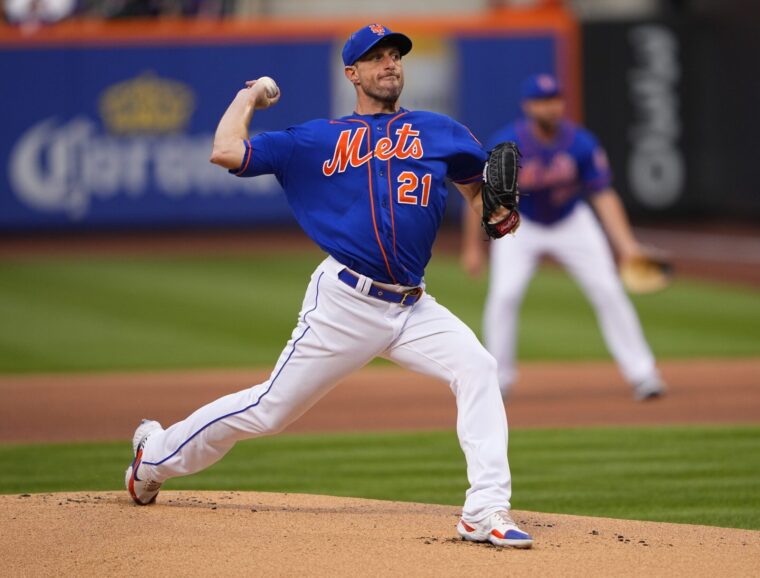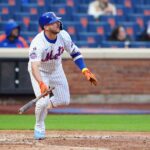
Gregory Fisher-USA TODAY Sports
There’s a lot of speculation and hoopla around the limitations on the infield shift and how it may affect various hitters. Earlier this week, I speculated about how the rule changes might impact various Mets’ hitters. There has been less chatter about how the changes will affect specific pitchers, though.
At the request of some commenters on the hitting article, let’s dive into how the new defensive alignment restrictions might affect the Mets’ pitchers, specifically their starting five (or six).
Max Scherzer
In Max Scherzer’s last 11 seasons of pitching, he has had a groundball/flyball ratio over 1.00 just once (1.07, in 2019), per Baseball Reference. Last season, Scherzer posted the lowest GB/FB rate of his career at 0.63. A large fly ball share definitely makes changes to the shift less noteworthy for Scherzer.
Scherzer is also still a strikeout pitcher. His 10.71 K/9 ratio from 2022 was the lowest he had posted in nine seasons, and he was still in the 89th percentile among pitchers in strikeout rate, per Baseball Savant. Although the shift does somewhat affect strikeout rates due to the way a pitcher attacks a batter, the difference is small enough not to be particularly significant.
The Mets shifted 35.9% of the time against righties and 51% against lefties when Scherzer pitched last season for a total shift rate of 43.6%, per Baseball Savant. That is a large enough chunk to wonder if the shift will affect Max. It is worthwhile to note, however, that Scherzer despised the shift and often complained about pitching in front of it (not that his opinion has any statistical significance).
There was a significant difference in BABIP against Scherzer with or without the shift last season. With the shift, batters recorded a .239 BABIP (on 134 balls in play); without it, their BABIP rose to .306 (206 balls in play). His total BABIP against was .279.
However, let’s put that supposedly stark difference into context. A 67-point difference in BABIP on 134 balls in play equals out to just nine more hits across the entire season. Considering that the shift mostly accounts for singles, that means Scherzer would’ve allowed a maximum of nine more total baserunners in 2022 if every single one of those balls was actually hit into the shift.
Although a nine-hit difference would have changed his total BABIP from .279 to .305, that just shows one of the limitations of a stat like BABIP in and of itself: nine more singles for a pitcher who strikes out more than one batter per nine and ranks in the top 4% of the league in walk rate (4.2%) is not that significant in the grand scheme of things. It is ultimately unlikely that all nine of those balls would have been hit into the shift, as even an extreme pull hitter does not pull the ball 100% of the time. This is exactly why BABIP is considered a fluky stat.
Overall, it is unlikely that the shift limitations will have a noticeable impact on Scherzer.
Justin Verlander
Although Justin Verlander’s GB/FB rate was listed at 0.62 in 2022, in his case, the stat is somewhat misleading. GB/FB ratio includes line drives as fly balls; if we remove those from the picture, Verlander had a 37.9% groundball rate and a 28.5% fly ball rate in 2022, which means he does allow more contact that could be affected by a shift. Additionally, his 21.1% line drive rate could have had results that were shift-impacted.
In fact, Verlander has been a groundball and line-drive pitcher for most of his career. 2018 was his only season in which he had a higher rate of fly balls than groundballs allowed.
Verlander is also a strikeout pitcher who prevents walks. He was in the 80th percentile in strikeout rate and the 94th percentile in walk rate in 2022. Those balls that aren’t put in play will not be affected by the shift.
The Astros shifted 32.6% against righties and a whopping 84.1% of the time against lefties when Verlander pitched last season. That would make it seem as if the shift limitations could have a much more significant impact on Verlander than Scherzer.
Indeed, there was a steep difference in BABIP against Verlander with vs. without the shift. Hitters put up a BABIP of .225 with the shift (227 BIP) and .271 without it (218 BIP), for a total of .247. That 46-point difference in BABIP would translate to a 10-hit increase over 227 BIP, which would have raised Verlander’s total BABIP to .270. Since a league-average BABIP is about .290-.300, this means that Verlander would have still allowed a lower rate of balls in play than usual even without the shift, and that is assuming that all 10 of those balls would be hits otherwise.
Like Scherzer, Verlander is unlikely to be significantly impacted by the changes in the shift.
José Quintana
Since we don’t have MLB data for Kodai Senga yet, his profile is somewhat of a wild card. Whatever stats he put up in Japan may change drastically with the altered ball, mound, and pitching schedule in the U.S.
Jose Quintana is a groundball pitcher, recording a 45.2% groundball rate and a 20.3% flyball rate for his career. His 27.7% line-drive rate could also be in play where the shift is concerned. Quintana is more susceptible to hits on balls in play than Scherzer or Verlander, allowing a .304 BABIP in 2022.
The Cardinals did not shift a ton behind Quintana, doing so just 10.2% of the time against righties and 56.2% of the time against lefties for a total of just 17.3% of 673 batters faced. His BABIP was identical on those plays: .304 with and without the shift. This suggests that Quintana won’t see too much of a change this season, since he didn’t pitch with the shift all that often, anyway.
Carlos Carrasco
Since the Correa signing fell through, the chatter about the Mets trading Carlos Carrasco has died down to a large extent. Therefore, Cookie will, presumably, be the Mets’ fifth starter in 2023.
Carrasco allowed a very high .339 BABIP in 2022, which partially explains why his FIP (3.53) was lower than his ERA (3.97). Although BABIP is considered somewhat fluky, Carrasco was in the 32nd percentile among pitchers in hard-hit rate and 29th percentile in expected batting average, which means that many of his hits allowed were likely earned rather than attributable to luck.
Over 71% of the contact Carrasco allowed in 2022 came on groundballs and line drives, and the Mets shifted 46.8% of the time when he pitched. This would suggest that he can be significantly impacted by shift changes, particularly because he gives up a lot of hard contact.
Ironically, though, Carrasco’s BABIP was actually better without the shift in 2022. He gave up a .353 BABIP with it (187 BIP) and a .329 BABIP without it (249 BIP).
It’s hard to definitively say that this will continue to be the case in 2022, but it doesn’t seem as if the shift did Carrasco any favors in 2022, suggesting that its removal is not particularly likely to have a negative impact in 2023.
David Peterson
Considering that the Mets have talked about giving their aging starters a break throughout the season, it is likely that David Peterson will see a healthy number of starts in 2023 even if the starting five manage to stay fully healthy (which is a pipe dream). Therefore, checking out his shift numbers is important.
Peterson allows a lot of hard contact; he was in the 18th percentile in average exit velocity and the 21st percentile in hard-hit rate in 2022.
The Mets seemingly shifted a lot with Peterson on the mound, doing so 25.2% of the time against righties and 68.8% of the time vs. lefties. However, because he faced almost four times as many righties as lefties, his total shift rate was only 34%.
Peterson did see a pretty stark difference in his BABIP with vs. without the shift, at .284 with it (88 BIP) and .333 without it (259 BIP). His total .317 BABIP was on the high side to begin with, and coupled with his hard-hit rate, the lack of a shift might hurt Peterson. Although this averaged out to only 4 more hits last year, if he sees a larger workload this season, there could be more of an aggregate loss.
Bottom Line
Although the Mets have several pitchers who were helped by the shift, the differences are not so stark as to be particularly concerned about them. Max Scherzer and Justin Verlander, in particular, have little to be overly concerned about, as both were around the 75th-80th percentile in hard-hit rate, and they both strike out a large rate of batters. A few singles here or there are definitely livable.
The bigger worry for the Mets is that their pitchers hold up health-wise and hold out against Father Time. They can try to find ideal infield alignments for their pitchers, but it’s not something to sweat about all that much.















